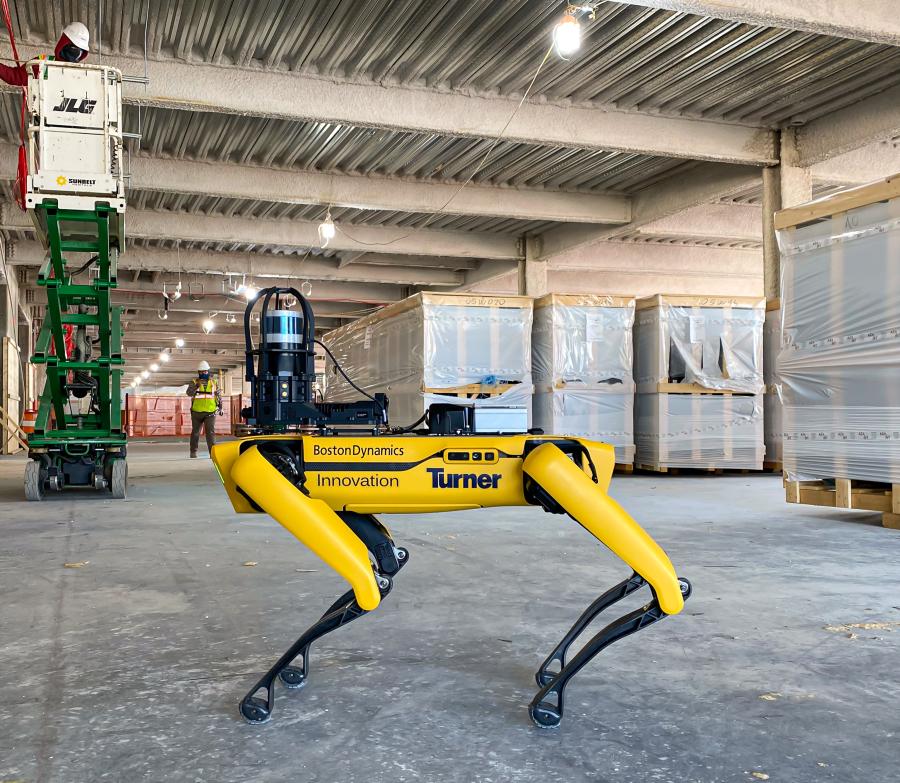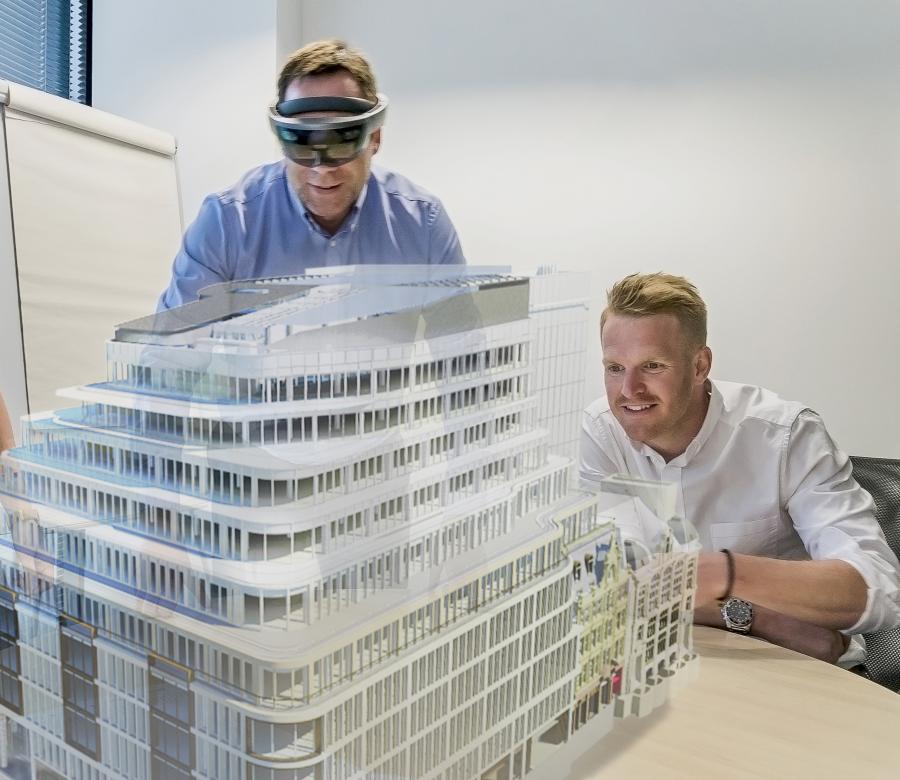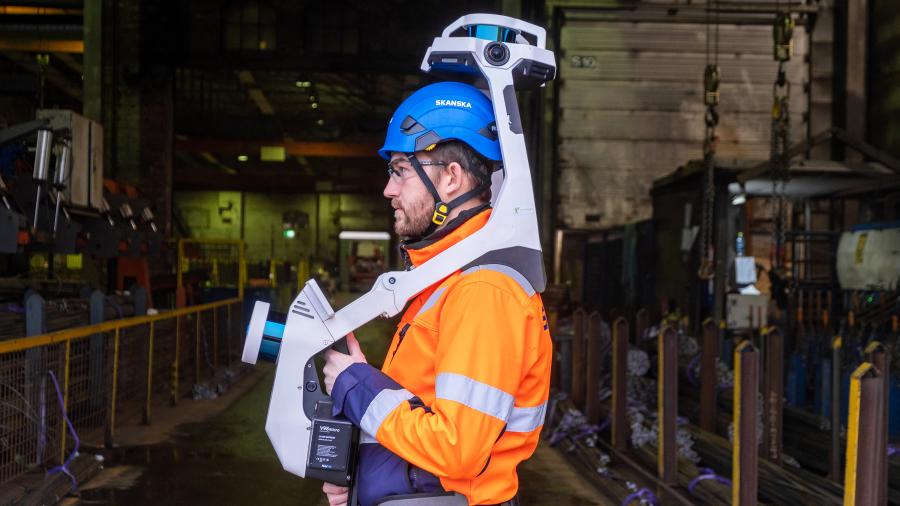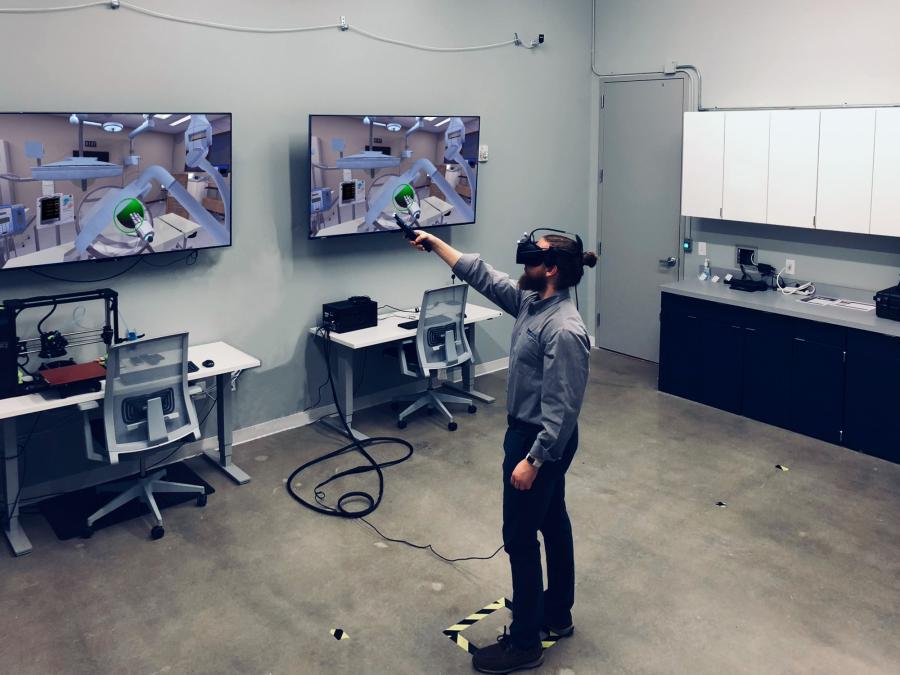Turner leverages the Boston Dynamics Spot robot to conduct routine site walks and automate reality capture tasks like site laser scanning and progress monitoring. Technological integrations with Spot can enhance jobsite documentation and improve productivity, schedule management, safety and quality.
(Turner Construction photo)
At every opportunity, construction firms large and small are looking to technology to help them become more efficient, streamline processes and improve sustainability.
Technological trends in large firms include building information modeling (BIM), the use of advanced building materials and construction robotics. Small to mid-size firms are embracing a variety of technologies, including drones, 360-degree photography and project management software to improve their efficiency. Safety continues to be at the forefront of the industry no matter the size of the firm, with technological advances in tools such as construction wearables to keep workers safe.
In the view of Michael Zeppieri, vice president, Skanska USA's Emerging Technology Team, some of the more common aspects of technology that improve the function of a job site involve less about specific technologies, and more about understanding how to improve efficiencies among project teams. Technology has not scaled as quickly in construction as it has in other industries, such as automotive or aerospace, but it still has an impact.
"Buildings don't come off assembly lines," Zeppieri said. "You generally don't have continuity from one job to the next. Locations change, teams change, the buildings change. To get to the futurism of technology that everyone is excited about, you must get people to adopt technology in a very pragmatic and real way."
Technologies used to improve the build experience don't have to be futuristic and expensive to have a positive effect. When visiting a job site, Zeppieri sees firsthand how relatively simple technologies, such as the use of QR codes, have a lasting impact on the user. Equally important is accessibility, with mobile-first and platform integration serving as the primary drivers for adoption in the field.
"When I go to a job site, and I see a superintendent get very excited because they can put a QR code on a room, scan it with their mobile device and it brings them to their punch list in one of our core platforms, that simplifies that process for them," he said. "The technology is not that sophisticated, but they get excited about it because it solves a problem."
Skanska USA's Emerging Technology Team is a small group compared with the overall size of the organization. Zeppieri and senior director Danielle O'Connell work with a core group of six people with an extended team of 20 to 30 people throughout the business to lead the integration of technology across the organization and with their clients.
"My biggest epiphany in the last year has been around data," O'Connell said. "It's been enlightening to see our teams start appreciating that they are collecting data whether they know it or not no matter what tool they are using, whether it's sensors like environmental or work wearables, or reality capture tools like 360-degree cameras or laser scanners. We can look at that data to be more proactive rather than reactive."
The question then becomes: how do companies get their employees on board with using technology? Many companies invest in technology and tools that are providing important information whether it is useful for a project today or a similar project in the future.
"An innovation isn't an innovation until it's in someone's hands and they are using that thing or doing that thing differently every day because of it," said Jim Barrett, vice president of Innovation of Turner Construction Company. "We are trying to help the industry with developing new technologies. Construction is laggard in terms of adopting new technology."
According to Barrett, there are many reasons for construction companies of all sizes to adopt technology into every project. In addition to the numerous benefits to the construction process, technology increases the probability of success, and success fosters a better culture.
"There is work associated with innovation," he said. "It's not easy. There are ways to increase the probability of success by creating a better culture and using innovation to create opportunities."
He said that Turner's Innovation team's work supports other divisions within the company.
"Our work is very missional; we try to think about innovation as helping people: we want to reduce waste and inefficiency so they can unlock their greater potential and apply their talents to add value," he said.
Skanska USA and Turner Construction Company are two of the largest construction firms in the United States. They manage thousands of projects each year totaling in the billions of dollars.
What about the small to mid-size firms, whose work is local or regional in scope? What technologies can they begin using now that will reap the rewards of efficiency and cost-savings for them and their clients?
Barrett encourages smaller firms to invest in technology.
"It's incumbent upon the smaller and medium sized companies to be constantly looking at new ways of doing things to support their people, improve their company, grow their business and improve their bottom line," he said.
He goes on to add that technology levels the playing field for small to medium to large companies. There are inexpensive yet effective tools available now that are easy to learn, such as Microsoft's AI Builder software.
"Those tools can be a catalyst to magnify the impact of a smaller firm and what they are capable of, and they can start competing on a performance level with the larger contractors," he said. "You don't need a large IT budget; you can use the tools that are becoming readily available. There is a huge opportunity for small to medium firms to deliver a level of capability and performance that is outsized to the size of their firm. I don't think people are quite aware of them. I encourage smaller companies to find some people in their organization and let them loose; encourage staff to investigate these new solutions."
One mid-size design build firm utilizing different technologies is The Milnes Engineering, Construction and Survey, headquartered in Tunkhannock, Pa., in the heart of northeastern Pennsylvania. They've embraced a variety of technologies including drones, project management software and robotic surveying equipment.
"Drones are a great tool to communicate with a client, to provide progress photos monthly or quarterly," said Earl Thomas, president and chief operating officer who oversees the construction division. "Our guys and the clients love it."
Milnes' chief surveyor, Lindy LaRue, understands the efficiency drones bring to the surveying side of the business, saving the clients not only time and money, but allowing them to make decisions on important details well before construction begins.
"With our initial mapping, we can take the drone and fly a 40-acre site in 20 minutes and have a survey grade photo that you can see down to one pixel per inch or less," said LaRue. "Every half an inch on the ground is one pixel on the screen. We then export that data into billions of points and create an object file out of that."
One of Milnes' clients wanted to build a large warehouse that would be seen from a high traffic road. LaRue's team was able to take the data gathered from the drone, export it into a 3D software program and digitally turn the building at different angles to show the client the best way to position the building for people to see the business' sign. This saved Milnes a great deal of time in the construction planning and their client a great deal of money, knowing with confidence how the building and signage would be positioned long before the first hole was dug.
Milnes' teams work together on projects due to the investments the company has made in various technologies. Robotic surveying equipment, for example, benefits their entire team, not only the survey division.
"Things we use that are newer to us would be robotic survey equipment to lay out building foundations," Thomas said. "Our construction team can take one point or two points and lay out the whole building with this robot. It's more advanced, goes quicker and is more efficient than how we used to do it."
Milnes' construction superintendents all have iPads out in the field. While they still have print blueprints in the office, the project management software loaded on their iPads gives them easy access in the field to every document for a specific project.
"It's very helpful when there are changes to the project on the fly," he said. "Right from the iPad they can send a quick e-mail to me and ask a question about a particular detail. They can highlight an area and send it in an e-mail. We can get that to the engineer or architect, and the super can quickly get their answer."
"From an engineering perspective, we are always looking for ways to streamline a project to get it under construction faster and more economically," said Michael Goodwin, vice president of Engineering. "We utilize OpenSite Designer land development software that is extremely helpful to develop concept plans in live interaction with project owners, contractors and other team members. It allows us to readily develop multiple design alternatives and can even provide high level cost estimating. We have used this tool with great success in recent years as we begin to shape a project from the client's mind to paper and ultimately to the build. Tools like this have really helped cut down the effort to develop civil design plans, and ultimately help to minimize the site development costs."
Technology has changed the construction process from the earliest phases of planning through to a project's completion. Gone are the days of thick binders filled with paperwork that are handed over to the client at the end of a project, only to sit on a shelf and collect dust. The more sophisticated firms deliver those closeout packages digitally now.
"We began to ask what value can we bring a client at the end of a project that is atypical from a standard closeout package," said O'Connell. "They've become more digital of course, but to take it one step further we've developed a closeout dashboard to help clients access all their project's data even faster. This enables them to make quick decisions and to implement preventative maintenance plans and tools to avoid potential catastrophes."
Closeout dashboards are an interactive PDF interface where Skanska USA's team links all the project's closeout information, including contact lists for vendors, warranty information and OEM information, into a digital user interface where all the information is stored and easy to access.
The amount of technology available can be overwhelming. Data collection apps, drones, robots, virtual reality devices and artificial intelligence software all combine to contribute to the efficiency and safety of a job site.
A technology that is right for one construction firm may not be needed by another. How do you know where to start? Construction trade shows and conferences are a great place to learn more about available technologies and speak with manufacturer representatives and current customers.
Requesting a demonstration by a construction software company or drone manufacturer is another way to see exactly how a particular technology can benefit your operation. CEG
Today's top stories




















